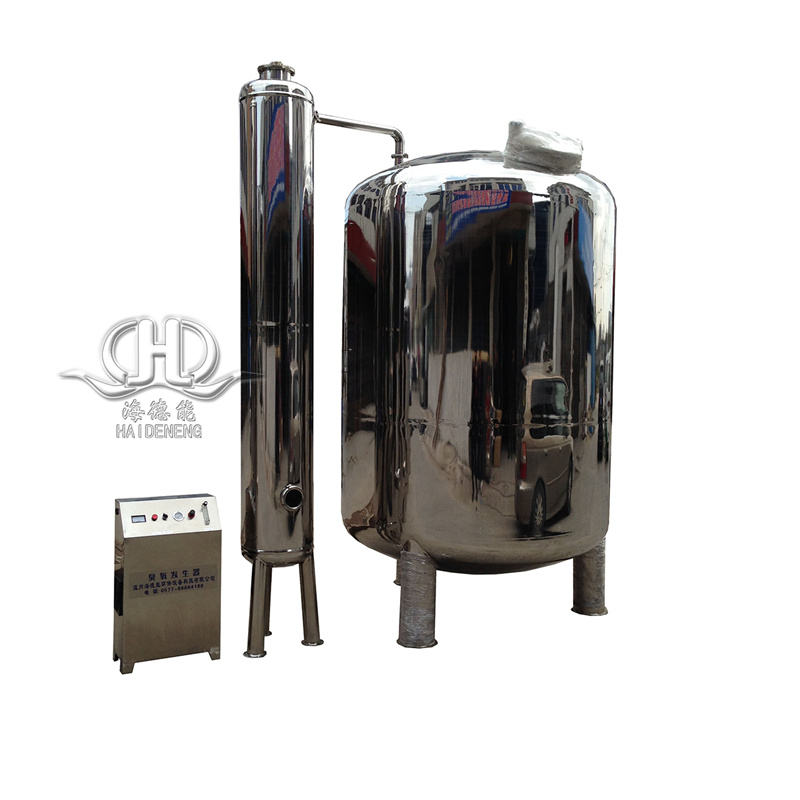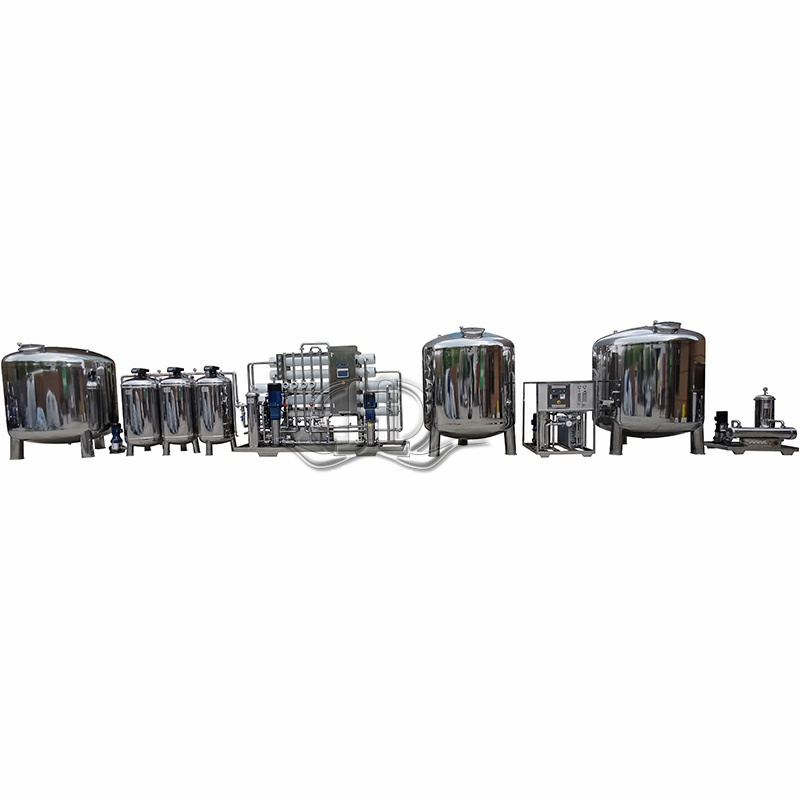Quartz Sand Filtration,activated Carbon, Filtration fine Filtration Belt Softening,reverse Osmosis Water Treatment System
Product description
Quartz sand filtration, activated carbon filtration, precision filtration belt softening, and reverse osmosis water treatment system
1、 Overall system architecture and core functions
This system is an integrated water treatment solution that achieves the conversion of raw water from turbid water to high-purity water through a three-stage process of “pretreatment softening desalination”. It is suitable for industrial production, drinking water purification, and other scenarios. The core process is as follows:
plaintext
Raw water → Quartz sand filtration → Activated carbon filtration → Softening treatment → Precision filtration → Reverse osmosis (RO) → Produced water
Core functions:
Pre treatment stage (quartz sand+activated carbon+precision filtration): remove suspended solids, colloids, organic matter, residual chlorine, and fine particles;
Softening stage: Reduce water hardness to prevent scaling of RO membrane;
Desalination stage (RO): Deeply remove dissolved salts and produce high-purity water.
2、 Technical principles and parameters of each unit
1. Quartz Sand Filtration
Principle: Utilize the pores between quartz sand particles to intercept large impurities such as sediment, rust, colloids, etc. in raw water, and reduce turbidity through “mechanical screening+deep interception” (such as reducing from 20NTU to ≤ 5NTU).
Key parameters:
Quartz sand particle size: 0.5-1.2mm, filter layer thickness 1-1.5m;
Filter flow rate: 8-12m/h, backwash intensity 15-20L/(m ² · s), lasting for 5-10 minutes.
2. Activated Carbon Filtration
Principle: Activated carbon with a specific surface area of ≥ 1000m ²/g removes residual chlorine (removal rate>99%), organic matter, and off color odors through physical adsorption (van der Waals force), and decomposes residual chlorine through chemical adsorption (surface functional groups) (ClO ⁻+C → Cl ⁻+CO ₂).
Key parameters:
Activated carbon type: Coconut shell activated carbon, iodine adsorption value ≥ 800mg/g;
Contact time: 10-15 minutes, residual chlorine in effluent ≤ 0.1mg/L.
3. Softening treatment
Principle: Calcium and magnesium ions (2R Na+Ca ² ⁺ → R ₂ – Ca+2Na ⁺) are removed by sodium ion exchange resin (such as Na type strong acid resin), and the hardness is reduced from 300mg/L (calculated as CaCO3) to ≤ 5mg/L.
Key parameters:
Resin exchange capacity: 1.8-2.0mol/L, regenerated salt consumption 80-100g/L resin;
Regeneration cycle: flow triggered (e.g. every 100m ³ of water processed) or time triggered (72 hours).
4. Fine Filtration
Principle: Using a 5 μ m PP melt blown filter or folding filter, the fine particles and colloids remaining after pretreatment are intercepted, so that the influent SDI (pollution index) is ≤ 5, protecting the RO membrane.
Key parameters:
Filter material: polypropylene, with a filtration accuracy of 5 μ m;
Replacement cycle: pressure difference>0.1MPa or operation for 1-3 months.
5. Reverse Osmosis (RO)
Principle: Under a pressure of 0.8-1.5MPa, water molecules pass through the RO membrane (pore size 0.0001 μ m), intercepting impurities such as salt and bacteria, and achieving a desalination rate of ≥ 95%.
Key parameters:
Membrane element: Aromatic polyamide composite membrane, with a single water production rate of 0.5-1m ³/h;
Recovery rate: 60% -80%, water conductivity ≤ 50 μ S/cm (when the TDS of the raw water is less than 2000mg/L).
3、 Progress of water quality and treatment effect
Turbidity (NTU), residual chlorine (mg/L), hardness (CaCO3, mg/L), conductivity (μ S/cm), and bacterial retention rate during the processing stage
Raw water ≤ 20 ≤ 1.0 ≤ 500 ≤ 2000 None
Quartz sand filtered ≤ 5 ≤ 0.5 ≤ 500 ≤ 1800 30% -50%
Activated carbon filtration ≤ 3 ≤ 0.05 ≤ 500 ≤ 1500 50% -70%
Softening treatment ≤ 3 ≤ 0.05 ≤ 5 ≤ 1500 50% -70%
Precision filtration ≤ 1 ≤ 0.05 ≤ 5 ≤ 1500 70% -90%
RO water production ≤ 0.5 ≤ 0.02 ≤ 1 ≤ 50 ≥ 99.9%
4、 Application scenarios
Industrial production water
Electronic semiconductor: chip cleaning water (conductivity ≤ 10 μ S/cm), compatible with EDI to produce ultrapure water (resistivity ≥ 18M Ω· cm);
Pharmaceutical industry: Preparation of purified water (compliant with USP and EP standards) for drug preparation and equipment cleaning;
Power industry: Boiler feedwater (hardness ≤ 0.03mmol/L) to prevent scaling and corrosion.
Civil and commercial water purification
Residential direct drinking water system: The conductivity of the produced water is ≤ 50 μ S/cm, and it is equipped with ultraviolet sterilization to meet the demand for direct drinking;
Rural drinking water renovation: treating high hardness and high turbidity groundwater to solve scale and microbial problems.
Special Scene
Laboratory water: As a basic equipment for pure water, it can be connected to ultra pure water machines in the future;
Offshore platform: Pre treatment of seawater desalination to reduce the load on subsequent RO systems (seawater needs to be pre treated to remove suspended solids and residual chlorine).
5、 System advantages and innovative design
Fully automated operation
PLC integrated control: sand filter/carbon filter backwash, softening regeneration, RO start stop linkage, supports remote monitoring (Modbus protocol);
Intelligent logic: Automatically adjust operating parameters based on water quality, such as increasing the frequency of sand filter backwash when the turbidity of raw water increases.
Anti pollution and long-life design
Pre treatment optimization: quartz sand and activated carbon gradation filtration to reduce RO membrane fouling (SDI ≤ 5), and extend membrane cleaning cycle to 6-12 months;
Softening precise control: Flow triggered regeneration, reducing salt consumption by 15% compared to the industry average, and resin lifespan of 3-5 years.
energy saving and environmental protection
Variable frequency control of high-pressure pump: energy consumption of 1.5-2kWh/m ³, saving 20% energy compared to traditional systems;
Concentrated water reuse: When TDS<1000mg/L, it can be reused for green irrigation to reduce emissions.
6、 Maintenance and troubleshooting
Component maintenance content cycle
Check the loss of filter material in quartz sand/activated carbon filters, and replenish or replace them every six months/year
Softening resin testing exchange capacity, regeneration/replacement every 2-3 years
RO membrane element chemical cleaning (acidic/alkaline) every 6-12 months
Replace the filter element of the precision filter every 1-3 months
Common troubleshooting:
RO water production decreases: when the membrane is contaminated, it is cleaned with citric acid (pH=2.5), and when the inlet water temperature is low, it is increased to above 15 ℃;
Softened water hardness exceeds the standard: resin failure requires replacement, and when the concentration of recycled salt is insufficient, it should be adjusted to 8% -10%.
7、 Selection and configuration suggestions
Selection of water production capacity
Small scale system: 1-10m ³/h (laboratory, small factory), covering an area of 5-10 square meters, with a power of 5-15kW;
Medium sized system: 20-50m ³/h (residential area, food factory), equipped with 50-100m ³ water tank, power 20-30kW;
Large scale system:>100m ³/h (industrial park), multiple sets of membranes connected in parallel, equipped with a central monitoring platform.
Adaptation of raw water quality
High sulfate water quality: The softening device uses sulfate type resin, and scale inhibitors are added before RO;
High silica water quality (SiO ₂>50mg/L): Silicon dispersant is added before RO to prevent silica scaling;
Seawater/brackish water (TDS>3000mg/L): Upgraded to secondary RO or equipped with energy recovery devices (such as PX pumps).
Industry customized solutions
Food and beverage: The water contact parts are made of 316L stainless steel, which meets FDA standards;
Chemical explosion-proof scenario: Select explosion-proof high-pressure pumps and control cabinets (explosion-proof grade Ex d IIC T6).
summarize
This water treatment system achieves efficient conversion from raw water to high-purity water through the full process design of “pretreatment softening RO”, especially suitable for scenarios with high requirements for water quality stability and automation. Its core value lies in the efficient collaboration of multi-stage filtration, low operation and maintenance costs, and the ability to adapt to different raw water qualities through flexible configuration. It is one of the mainstream solutions for industrial and civilian water treatment.







